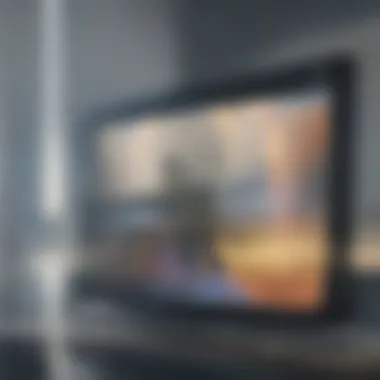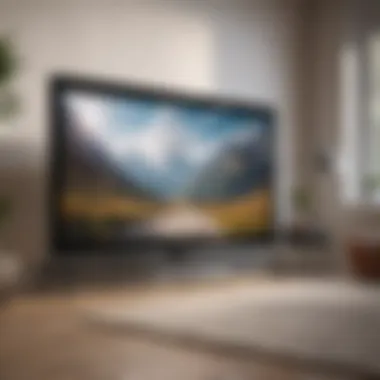Effective Solutions for Cleaning Your TV Screen


Intro
Maintaining a clean television screen is essential for enhancing the viewing experience. A clear and streak-free screen can significantly improve picture quality and the overall enjoyment of movies, shows, or games. However, many homeowners and technology enthusiasts often overlook the importance of proper cleaning techniques. Various types of TV screens, including LCD, LED, OLED, and plasma, require distinct approaches to cleaning, each necessitating unique tools and materials to avoid damage.
This article will delve into effective cleaning methods tailored to different screen types, while also dispelling myths surrounding screen maintenance. Practical advice will be provided to help readers navigate the dos and don'ts of screen cleaning, ensuring they preserve the longevity and clarity of their devices. As viewers invest substantial time and resources in their television sets, understanding effective cleaning solutions becomes imperative.
The cleaning methods discussed will not only highlight the best practices but also expose common misconceptions that lead to unintentional harm to screens. By the end of this guide, homeowners will have a thorough understanding of how to maintain their televisions in peak condition, enhancing the viewing experience for themselves and their guests.
Understanding Your TV Screen
Cleaning a TV screen effectively starts with understanding its structure and the materials used in its production. Each type of television screen has its own unique properties that affect the cleaning process. Knowing these details is crucial for selecting the right cleaning methods and solutions. This knowledge can help prevent damage to the screen and ensure prolonged use. Understanding the various types of screens also helps homeowners appreciate the technology they interact with daily.
Types of TV Screens
LCD stands for Liquid Crystal Display. This technology is widely respected for its thin design and energy efficiency. A key characteristic of LCD screens is their use of liquid crystals, which modulate light to display images. LCDs are known for their vibrant color accuracy and affordability, making them a popular choice for many consumers. The light source usually comes from fluorescent lamps, which contribute to their brightness. However, LCD screens can suffer from issues like image retention, especially if not cleaned regularly, leading to performance degradation over time.
LED
LED technology is an advancement of LCD. LED panels use light-emitting diodes to provide backlighting. The key feature of LED screens is their improved contrast ratios and brightness levels compared to traditional LCDs. LED screens are also thinner and lighter, which makes them more versatile for installation. This technology has made significant inroads into households, due to its energy efficiency and longer lifespans. Nevertheless, just like LCDs, LED screens can accumulate dust and fingerprints, which can impair the viewing experience if not cleaned properly.
OLED
OLED, or Organic Light Emitting Diodes, represents another leap in screen technology. It eliminates the need for backlighting by allowing each pixel to emit its own light. A notable characteristic of OLED displays is their ability to achieve true blacks, enhancing contrast. This results in stunning visuals, making OLED screens ideal for cinematic experiences. However, OLEDs can be more expensive, which makes them a consideration for more discerning buyers. They are also susceptible to screen burn-in, and thus require careful cleaning practices.
Plasma
Plasma screens utilize small cells filled with ionized gases that emit light when electrically charged. The main appeal of plasma technology includes exceptionally rich colors and broad viewing angles. Still, plasma screens have fallen out of favor due to their thicker designs and higher energy consumption compared to modern alternatives. One of the disadvantages is their heavy weight and vulnerability to screen burn-in and static images, which makes regular cleaning important to maintain quality.
Common Screen Materials
Glass
Glass is a prevalent material in many TV screens. It offers durability and an attractive finish. Its smooth surface provides clarity to images displayed. However, glass can be prone to scratches if not cared for properly. Cleaners containing abrasive materials can cause damages, so gentle cleaning practices are necessary.
Plastic
Plastic panels are often utilized for lighter screens. They are cheaper to manufacture compared to glass. A major advantage is their resistance to shattering, making them safer in homes with children. However, plastic can be more susceptible to scratches and discoloration over time. Regular cleaning is needed to maintain their appearance.
Coatings
Many modern TVs have specialized coatings to improve visual quality. These coatings can reduce glare and enhance color richness. However, they require specific cleaning solutions to prevent degradation. Using the wrong cleaner can strip these coatings, compromising the visual quality. Understanding the coatings on your screen will dictate the appropriate care to maintain optimal performance.
Why Cleaning Your TV Screen is Important
Cleaning your television screen goes beyond mere aesthetics. It plays a significant role in optimizing the viewing experience while also extending the lifespan of your device. Dust and smudges can obscure details in images and colors, which impact enjoyment during movies or gaming. A clean screen allows for a clear visual encounter. This clarity is essential, especially in high-definition formats that boast of vivid colors and intricate details.
Impact on Viewing Experience
The visual quality of a television depends vastly on the clarity of its screen. A clean screen can dramatically improve the viewing experience. When dirt accumulates, it scatters light and creates a hazy effect that distracts from the picture quality. This interference can lead to eye strain during extended viewing periods, affecting comfort and satisfaction.
Keeping the screen spotless ensures optimal brightness and contrast levels. Viewers are able to appreciate the director's visual intent, from nuanced shades in films to intricate graphics in video games. Therefore, regular cleaning is not simply a chore; it is a measure to enhance your cinematic or gaming experience.
Preventing Damage


Failure to clean your TV screen regularly can cause more than just a subpar viewing experience. Certain substances, if left unaddressed, can corrode or damage the screen gradually. For instance, greasy fingerprints can attract dirt, which forms a stubborn layer that is harder to remove over time. If abrasive materials are used during cleaning, they can scratch the screen.
Using inappropriate cleaning agents can further lead to irreversible damage. Chemical cleaners might contain harsh solvents that are better suited for other surfaces but can ruin the protective coatings on your screen. This is why understanding the proper cleaning techniques and materials is crucial.
Effective cleaning not only boosts your viewing pleasure but preserves the health of your television, ensuring that it lasts longer and performs better. Keeping your screen well-maintained is a long-term investment in smart entertainment.
What Not to Use for Cleaning
Many homeowners overlook the importance of knowing what is safe for cleaning their TV screens. Using the wrong cleaning materials can lead to costly damages. This section aims to elucidate specific items that are best avoided during the cleaning process. Understanding these elements is crucial, as a gentle approach is necessary for different screen types.
Common Household Cleaners
When it comes to cleaning products, common household cleaners are often the first choice for many. However, these cleaners can contain chemicals that may harm your TV screen. Products that contain ammonia, or alcohol as their main ingredient, should be avoided. These substances can strip protective coatings or lead to discoloration of the screen’s surface. Additionally, the harshness of these cleaners can result in streaking and ultimately deteriorate the screen’s clarity.
Therefore, opting for natural solutions like distilled water is a wiser move. Many safety concerns arise from misinformation about what qualifies as an effective cleaning solution. Consumers should be aware that a clearer understanding of proper cleaning practices can safeguard their investments, ensuring a prolonged lifespan for their televisions.
Paper Towels and Rags
Another common mistake many make is using paper towels or regular cloth rags. These materials can be abrasive. Even if the texture appears soft, paper towels may scratch the screen, especially if they are used to wipe away dirt or smudges. This risk is significantly heightened when using rougher cloths or low-quality fabrics that might not be designed for electronic care.
Instead, soft microfiber cloths should be the go-to choice. Microfiber is engineered to lift away particles without leaving scratches or residue. It is gentle on screens, making it an essential tool for anyone who cares about the integrity of their TV. In the realm of screen maintenance, avoiding harmful materials is as critical as using appropriate ones.
Recommended Cleaning Solutions
Selecting the right cleaning solution for your TV screen is pivotal for maintaining both clarity and integrity. Choosing an appropriate method ensures that the screen retains its sharpness and does not suffer from damage caused by harsh chemicals. This section explores various cleaning solutions, including distilled water, vinegar solutions, and commercial screen cleaners, all specifically suitable for TV screens.
Distilled Water
Distilled water stands out as a gentle and effective option for cleaning television screens. Unlike tap water, which may contain minerals and impurities, distilled water is free from any contaminants. Using distilled water prevents streaks that can form from leftover minerals when the water dries. It is especially recommended for routine cleaning since it will not damage the delicate coatings often present on modern screens.
Key Advantages of Distilled Water:
- Non-abrasive: Does not scratch the screen.
- Leaves No Residue: Drys clear without spots.
- Cost-Effective: Readily available at supermarkets and pharmacies.
Using distilled water is as simple as dampening a microfiber cloth with it and gently wiping the screen in circular motions. This method effectively removes light smudges and dust without the risk of damaging the screen’s surface.
Vinegar Solutions
Vinegar can serve as an alternative cleaning agent due to its natural properties. A diluted solution, typically consisting of equal parts distilled vinegar and water, can be effective against stubborn dirt and fingerprints. The acetic acid in vinegar helps to dissolve grime while being less risky than many commercial cleaners.
Considerations for Vinegar Solutions:
- Dilution is Key: Always mix with equal parts water to minimize acidity.
- Spot Testing Recommended: Test on a small hidden area first to ensure no adverse reaction occurs.
- Odor: Vinegar has a strong smell that dissipates once dry.
Apply the solution to a microfiber cloth, not directly to the screen, to prevent excess liquid from damaging internal components. Use gentle pressure and circular movements to clean the screen safely.
Commercial Screen Cleaners
For those who prefer a ready-made solution, many commercial screen cleaners are available specifically designed for electronics. These products are formulated to be safe for various types of screens, including LCD and OLED. They often come with anti-static properties that help repel dust and fingerprints once cleaned.
Benefits of Commercial Screen Cleaners:
- Convenience: Easy to use and often includes a spray nozzle for controlled application.
- Formulated Safety: Specifically designed for screen materials, reducing the risk of damage.
- Additional Features: Some may include UV protection or anti-glare properties.
When using commercial cleaners, follow the manufacturer’s instructions carefully. It is generally advisable to spray the cleaner onto a cloth rather than directly onto the screen, avoiding any liquid seeping into the device.
"Choosing the right solution is essential for maintaining both clarity and integrity of your TV screen."


Cleaning Techniques
Effective cleaning techniques are vital for maintaining a clean television screen. The methods employed directly influence the clarity of the screen and prevent potential damage. A thorough understanding of proper cleaning techniques can help avoid streaks, scratches, or other issues that may arise from improper care.
Using a Microfiber Cloth
Microfiber cloths are ideal for cleaning sensitive surfaces such as TV screens. They are designed to lift dust, dirt, and fingerprints without scratching the display. Unlike common rags, microfiber is gentle yet effective. A cloth with a tight weave can trap debris better than traditional fabrics. When using a microfiber cloth, it is important to use a clean section for each wipe. This practice reduces the chance of transferring dirt back onto the screen.
To use a microfiber cloth effectively:
- Always dry wipe first to eliminate loose dust.
- Use light pressure to avoid damaging screen coatings.
- Make circular motions rather than straight lines for consistent coverage.
Damp vs. Dry Cleaning
The choice between damp and dry cleaning depends on the nature of the grime on the screen. Dry cleaning, using just a microfiber cloth, works well for light dust and fingerprints. It minimizes the risk of moisture affecting the electronics behind the screen.
Damp cleaning involves slightly moistening the cloth, which can help remove stubborn smudges. It's crucial to ensure that the fabric is not soaked to prevent water from entering the screen edges. Here are some key points to remember:
- Dry cleaning is generally sufficient for everyday maintenance.
- Damp cleaning is more effective for sticky or oily residues.
- Always turn off the TV before cleaning to avoid accidental damage.
Streak-Free Methods
Achieving a streak-free screen requires attention to detail and patience. One common method is to use a solution recommended for screens, applied sparingly to a microfiber cloth. The solution should never be spritzed directly onto the screen. Instead, hold the cloth a few inches away and apply the cleaner to it first.
Important considerations for streak-free results include:
- Update your cloth often; old cloths can harbor grit.
- Wipe in a consistent pattern, such as left to right, then top to bottom.
- If streaks persist, revisit the damp cleaning technique, as moisture can eliminate residue more effectively.
"Maintaining a streak-free appearance on a TV screen enhances viewing pleasure and extends the lifespan of the display."
These techniques form an essential part of any homeowner's routine, contributing to both aesthetic and functional aspects of television ownership. Their correct application ensures that screens remain clear and visually appealing.
Frequency of Cleaning Your TV Screen
Understanding how often to clean your TV screen is key to maintaining its clarity and longevity. Frequency of cleaning is not just about aesthetics; it directly impacts the viewing experience and the device's lifespan. A dirty screen can distort images and colors, making the content less enjoyable. Regular cleaning helps in reducing dust accumulation, fingerprints, and smudges that inevitably appear over time, especially if the television is in a high-traffic area.
Consideration of several factors determines how often one should clean a TV screen. Each household may have different needs, and recognizing these can lead to better maintenance practices.
Factors Influencing Cleaning Frequency
Several elements can affect the frequency with which you should clean your TV screen:
- Location: Televisions positioned in kitchens or near entrances often gather more dust and grease from cooking or foot traffic. If your TV is placed in one of these areas, consider cleaning it more often.
- Usage: If you frequently watch TV, chances are your screen will get smudged more quickly. High usage can lead to fingerprints and dust accumulation, necessitating more frequent cleaning sessions.
- Pets: Houses with pets often deal with additional contaminants. Hair, dander, and even nose prints from curious pets can require more regular cleaning.
- Environmental Factors: Smoke, humidity, and pollutants can also contribute to the dirtiness of the screen. A smoky or humid environment will cause more grime to settle on the surface.
Understanding these factors can aid in determining a personalized cleaning schedule that protects your investment and keeps your viewing experience enjoyable.
Routine Maintenance
Establishing a routine maintenance plan is essential for keeping your TV screen in good shape. Regular inspections for smudges and dust can go a long way.
Here are some practical steps for routine maintenance:
- Weekly Checks: Set a reminder to check your screen every week. Use a dry microfiber cloth to gently wipe away dust, ensuring there are no buildups that could lead to harder-to-remove stains later.
- Monthly Deep Cleaning: Once a month, consider dedicating time for a more thorough clean. This could include dampening the microfiber cloth slightly with a recommended cleaning solution, such as distilled water or a vinegar mix, to tackle tougher spots.
- Avoid Over-Cleaning: As with any cleaning process, overdoing it can lead to damage. Always assess the need for cleaning before proceeding. Excessive wiping or using harsh methods can degrade the screen coating over time.
By incorporating these practices into your routine, you can ensure your TV screen remains clean and visually appealing for years. This contributes to not just better viewing but also helps preserve the hardware itself.


Addressing Stubborn Smudges and Stains
Dealing with stubborn smudges and stains on your TV screen is more than just an aesthetic concern; it directly affects your viewing experience. These blemishes can distract from the rich colors and clarity that modern screens offer. Over time, if not properly addressed, these marks can become increasingly difficult to remove, leading to frustration. Knowing how to effectively tackle these issues can preserve the visual quality of your screen and extend its lifespan.
Safe Removal Techniques
Removing stubborn smudges and stains requires a gentle approach to avoid damaging the screen. Here are some effective techniques you might consider:
- Use Distilled Water: Begin by dampening a microfiber cloth with distilled water. This type of water is free from minerals that can leave residue. Carefully wipe the stained area in a circular motion.
- Vinegar Solution: If the stain persists, a mixture of equal parts distilled water and white vinegar can be effective. Apply this solution to the microfiber cloth, not directly on the screen, to prevent excess liquid from seeping into the edges.
- Commercial Cleaners: Some commercial screen cleaners are specifically designed for TV screens. Ensure they are free from harsh chemicals and ammonia that can damage the screen's coating.
- Gentle Pressure: While cleaning, apply light pressure. For persistent stains, you may need to press a bit harder, but avoid using anything abrasive or rough.
- Dry with a Clean Cloth: After using any cleaning solution, always finish by wiping the screen with a dry microfiber cloth. This helps prevent streaks and ensures a clear finish.
Following these techniques can effectively remove stubborn marks while maintaining the integrity of the screen.
When to Seek Professional Help
Some stubborn stains may require professional assistance, especially if the marks do not respond to standard cleaning methods. Here are instances when it is wise to consider this option:
Professional intervention may be preferable if:
- You notice any discoloration or damage to the screen after attempting to clean it yourself.
- The stains are deep-seated and difficult to identify, indicating potential underlying issues.
- You lack the right cleaning supplies or techniques, risking more damage if you attempt to resolve it independently.
Professional cleaning can be a safe alternative. Technicians use specialized tools and chemicals effective for various screen types.
Protecting Your TV Screen Post-Cleaning
Maintaining the cleanliness of a television screen is an essential aspect of ensuring a high-quality viewing experience. However, the care does not end after cleaning; protecting the screen post-cleaning is equally important. Adequate protection helps to extend the life of the screen and preserve its clarity, reducing the need for frequent maintenance. Understanding how to shield your TV screen from potential damage ensures longevity and optimal performance.
Screen Protectors
Screen protectors serve as the first line of defense against physical damage and smudges. They can prevent scratches caused by dust or accidental contact. A good screen protector will not only keep the screen clean but also reduce glare, enhancing visibility under various lighting conditions.
When choosing a screen protector, consider the following factors:
- Material Quality: Look for tempered glass or high-quality plastic that can resist impact and scratches.
- Easy Application: Ensure the protector is easy to install without bubbles or dust getting trapped.
- Compatibility: Make sure the protector fits well with your particular TV model and screen size to ensure complete coverage.
Using a screen protector is a practical choice. It can save time and effort spent on cleaning while keeping your TV's picture quality intact.
Proper Placement and Environment
The placement of your television is critical in maintaining its pristine condition. Avoid locations that expose the screen to direct sunlight. Prolonged exposure to sunlight can not only lead to fading colors on the screen but can also increase the internal temperature, which may harm electronic components over time.
Consider the following when setting up your TV:
- Distance from Windows: Position your TV away from windows to minimize sunlight exposure.
- Furniture Arrangement: Ensure there is enough space around the TV to avoid accidental knocks from furniture.
- Humidity Control: Keep the TV in an environment with controlled humidity to prevent moisture damage, especially in areas prone to dampness.
Having the TV set correctly in a safe environment provides additional protection against dust and accidental impacts, which could otherwise necessitate frequent cleaning and repairs.
Epilogue
Cleaning your TV screen is more than just a matter of aesthetics; it plays a crucial role in enhancing your overall viewing experience. A clean screen significantly improves picture clarity, allowing for an immersive experience whether you are watching movies, news, or playing video games. Dust and smudges can severely detract from the visual quality, leading to frustration and reduced enjoyment.
Beyond the immediate benefits of improved image quality, regular maintenance helps prolong the life of your television. Many modern smart TVs come equipped with delicate coatings that can wear down due to improper care, potentially leading to irreversible damage. Using suitable cleaning solutions and techniques ensures that these coatings remain intact.
It is also essential to consider the environment in which your TV is placed. Factors like humidity, dust levels, and sunlight exposure can affect how frequently cleaning is needed. Therefore, developing a maintenance routine tailored to your specific setup can yield the best results.
In summary, cleaning your TV screen is an investment. Taking the time to understand the methods and tools suitable for your specific screen type pays off in the long run, offering clearer visuals and protecting your investment. Regularly applying the tips discussed throughout this article will not only maintain your television's appearance but also enhance its functionality.
Final Thoughts
Maintaining a clean television screen is a straightforward yet often overlooked aspect of home entertainment. The convergence of aesthetics and functionality cannot be understated. While it may seem trivial, the difference between a dusty screen and a pristine one is stark. It can change how you perceive content, making it more enjoyable and engaging.
In today’s digital age, where large screens and bright visuals dominate our lives, ensuring that your TV remains in impeccable condition should be a priority. By utilizing recommended cleaning solutions, implementing safe practices, and safeguarding your screen post-cleaning, you can achieve the optimum viewing experience.
As the final takeaway, make cleaning your television part of your home maintenance routine. Simple actions lead to significant benefits. Therefore, commit to giving your TV the care it deserves.



